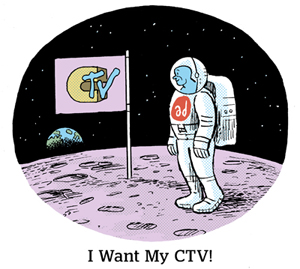At the Next TV Summit on Tuesday, AC/DC’s “Thunderstruck” was the walk-on music for a panel debating the death of broadcast.
A classic ’90s throwback tune was perhaps appropriate considering “1990 was the last time broadcast mattered,” quipped Next TV reporter David Bloom, the moderator of the event, which is part of NYC TV Week.
But legacy TV companies and the technology providers that serve them have reason to push back against an early eulogy for broadcast television.
As old players reinvent themselves and new ones join the scene, TV distribution is coming full circle.
Content delivery, be it linear or streaming, is a forked road that ultimately goes to the same place (or screen), said Jim Long, CEO of Didja, a company that develops local US news apps, which are available in 21 DMAs (as of January).
Making a distinction between content that’s streamed versus broadcast content is “like asking whether an Amazon package is arriving on asphalt or cement,” Long said. “The road [itself] doesn’t matter.”
Blocking that road, however, are the numerous technical differences between an over-the-air broadcast and content that streams over the internet. Slapping a broadcast signal onto a connected device is no simple task.
Signal to noise
Many broadcasters are now focused on bringing their networks to mobile devices, starting with the news.
The Advanced Television Systems Committee (ATSC) has been working to set technical standards for cross-channel TV distribution since the ’80s. The group’s latest standard, ATSC 3.0, was designed specifically with mobile distribution in mind.
Sinclair Broadcast Group started using this standard in 2019 to build mobile receiver chips for news streaming so device owners could stream local news in their DMA through an app.
Today, Sinclair reaches 92% of the country with local news, said Rob Weisbord, the company’s president of local news and marketing services.
Sinclair expects that number to grow as it “lights up” more of its station transmitters, Weisbord said, referring to the process of converting linear transmitters into a “hybrid” that can process IP signals.
So far, Sinclair has lit up just over half of its transmitters, he added.
All that “streaming” really means, after all, is that there is an IP address involved in the transmission, said Stephane Guez, CTO of Dalet, a media distribution software.
Didja also uses the ATSC standard to develop local news apps catered to specific DMAs.
“You can do a lot of cool sh*t on the internet,” Didja’s Long said, “but you’re never going to get rid of broadcast.”
Just push play
That said, the bigger the screen, the bigger the hype.
Free ad-supported TV, or FAST, is one mechanism broadcast and cable TV networks are now using to shoulder their way into streaming platforms. FAST mimics the channel structure of broadcast. Viewers join midstream rather than starting from the beginning of an episode as they would generally do with on-demand content.
And, apparently, it’s working. FAST is the fastest-growing tier of streaming TV, according to Kantar.
The success of FAST is evidence that broadcast TV can make a comeback – if it’s done right, said Kevin Dunaway, VP of affiliate relations and content development at VUit, a subsidiary of OTT solutions provider Syncbak, that helps broadcasters insert themselves into streaming by creating FAST channels.
Heck, even legacy TV shopping network QVC is going FAST.
David Apostolico, SVP of platform strategy, development and distribution at Qurate Retail Group (which owns QVC) broke the news on stage at the event Tuesday. He noted that the platform just hired its first president of streaming for the job, and he told the audience they can expect QVC’s FAST channel to officially drop on November 1.
Newbies
But broadcasters aren’t just vouching for themselves. Digital-native streaming distributors are rushing to cash in on the live TV hype, too.
Amazon recently snagged the NFL’s Thursday Night Football package, and Fox-owned Tubi just added FAST channels to complement its on-demand library.
And Google’s getting serious about live TV, too.
“Linear is here to stay,” Shalini Govil-Pai, VP of TV platforms at Google, told AdExchanger. “I’m still bullish on linear … because it takes the burden of choice off of consumers.”
YouTube held its first upfront earlier this year, where Allan Thygesen, president of Google’s ads biz in the Americas, announced that YouTube TV now makes up more than half of all CTV viewing hours in the US.
(For reference, YouTube TV is just a FAST channel that’s not free. It’s a virtual multichannel video programming distributor, or vMVPD.)
Google’s next step on the live linear front is to grow its FAST channel business on Google TVs.
But Google also intends to maintain its presence at the upfronts with YouTube Brandcast, Govil-Pai said.
The goal, she said, is to give advertisers access to live Google TV inventory on top of their YouTube TV buys.
Guess it really is true: Everything old is new again.














